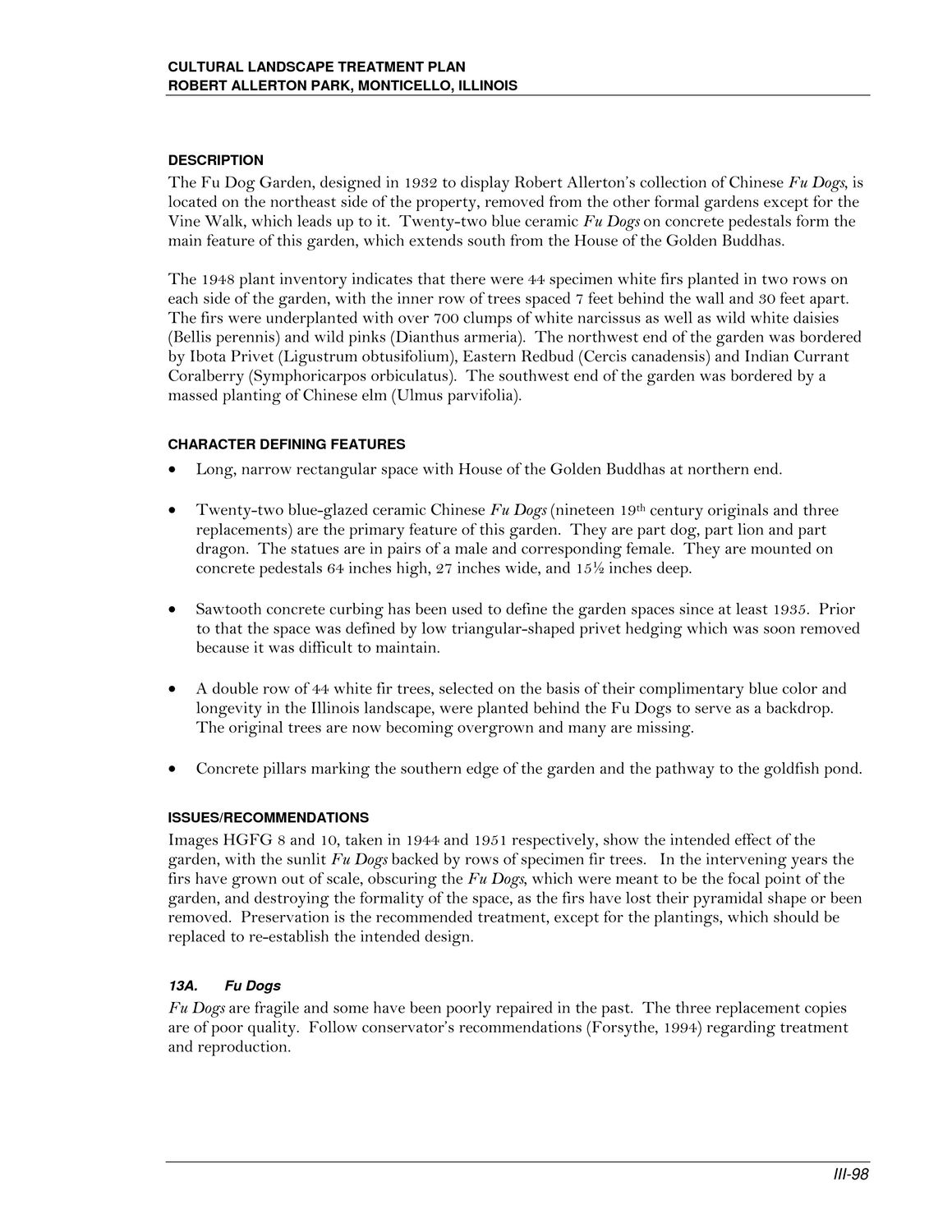| |
| |
Caption: Map of UIUC (2001) (Allerton)
This is a reduced-resolution page image for fast online browsing.

EXTRACTED TEXT FROM PAGE:
CULTURAL LANDSCAPE TREATMENT PLAN ROBERT ALLERTON PARK, MONTICELLO, ILLINOIS DESCRIPTION The Fu Dog Garden, designed in 1932 to display Robert Allerton’s collection of Chinese Fu Dogs, is located on the northeast side of the property, removed from the other formal gardens except for the Vine Walk, which leads up to it. Twenty-two blue ceramic Fu Dogs on concrete pedestals form the main feature of this garden, which extends south from the House of the Golden Buddhas. The 1948 plant inventory indicates that there were 44 specimen white firs planted in two rows on each side of the garden, with the inner row of trees spaced 7 feet behind the wall and 30 feet apart. The firs were underplanted with over 700 clumps of white narcissus as well as wild white daisies (Bellis perennis) and wild pinks (Dianthus armeria). The northwest end of the garden was bordered by Ibota Privet (Ligustrum obtusifolium), Eastern Redbud (Cercis canadensis) and Indian Currant Coralberry (Symphoricarpos orbiculatus). The southwest end of the garden was bordered by a massed planting of Chinese elm (Ulmus parvifolia). CHARACTER DEFINING FEATURES • • Long, narrow rectangular space with House of the Golden Buddhas at northern end. Twenty-two blue-glazed ceramic Chinese Fu Dogs (nineteen 19th century originals and three replacements) are the primary feature of this garden. They are part dog, part lion and part dragon. The statues are in pairs of a male and corresponding female. They are mounted on concrete pedestals 64 inches high, 27 inches wide, and 15½ inches deep. Sawtooth concrete curbing has been used to define the garden spaces since at least 1935. Prior to that the space was defined by low triangular-shaped privet hedging which was soon removed because it was difficult to maintain. A double row of 44 white fir trees, selected on the basis of their complimentary blue color and longevity in the Illinois landscape, were planted behind the Fu Dogs to serve as a backdrop. The original trees are now becoming overgrown and many are missing. Concrete pillars marking the southern edge of the garden and the pathway to the goldfish pond. • • • ISSUES/RECOMMENDATIONS Images HGFG 8 and 10, taken in 1944 and 1951 respectively, show the intended effect of the garden, with the sunlit Fu Dogs backed by rows of specimen fir trees. In the intervening years the firs have grown out of scale, obscuring the Fu Dogs, which were meant to be the focal point of the garden, and destroying the formality of the space, as the firs have lost their pyramidal shape or been removed. Preservation is the recommended treatment, except for the plantings, which should be replaced to re-establish the intended design. 13A. Fu Dogs Fu Dogs are fragile and some have been poorly repaired in the past. The three replacement copies are of poor quality. Follow conservator’s recommendations (Forsythe, 1994) regarding treatment and reproduction. III-98
| |